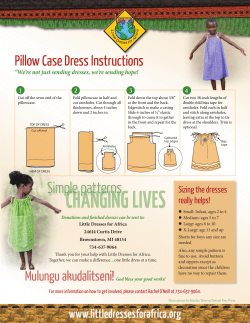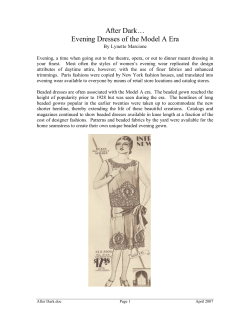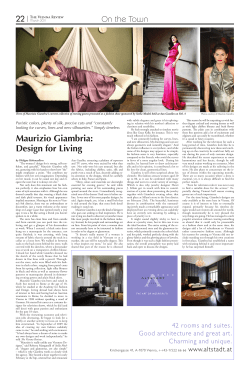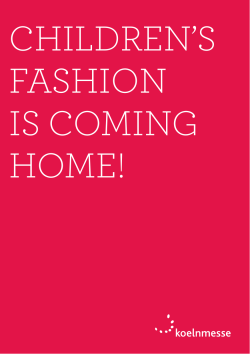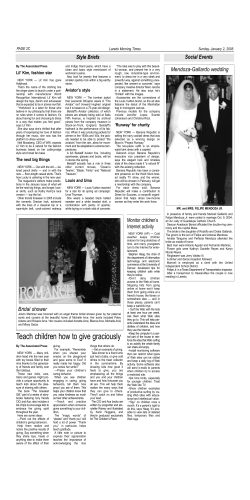
Document 91859
1920’ S F ASHION FOR Y OUR B ODY T YPE Introduction Over the last few years since I have been building vintagedancer.com, I have wafted and waivered over having a favorite era of clothing. I find them all fascinating for different reasons, which is why I enjoy researching and writing about the various types of clothing from one time period to the next. My fascination with the 1920’s has been growing over the years, but it wasn’t until last summer when I bought a house built in 1920 that I really dove into 1920’s fashion research. This led me to start my next book, the 1920’s Style Guide, where I wanted to take the mystery out of dressing in 1920’s era clothing. The book has turned in a free 12 week blog series which you can sign up for here: http://www.vintagedancer.com/1920s/1920s-style-guide The series includes an extensive history and explanation of each type of clothing, for both women and men, as well as hundreds of illustrations and photos of 1920’s clothing, shoes and accessories. It will be full of fashion information and, more importantly, practical application tips on choosing what to wear, styling your hair, and making clothing easily, even for the novice seamstress. Sounds great, right? It is an exciting project that I hope will leave you with a greater appreciation of 1920’s fashion. While there any many fashion books on the 1920’s available today, most leave out one very important topic: fashion taste. Not that women in the 1920’s didn’t have any taste in good fashion, but just like today, there are certain rules to choosing the most flattering clothing for your particular body style. These rules have not changed much since the 1920’s. Basic advice for stockier folks to wear darker colors and tall women to avoid tall hats and shoes is still applicable today. What is unique is not the rules but the application of the rules to the particular styles of the day. When shopping for or making 1920’s clothing, how do you know what color or style will look best on you? Since not all body types are alike, not all colors or styles will flatter you. This guide to 1920’s Fashion for Your Body Type will help you understand the advantages and challenges for your body and face, as they were evaluated in the 1920’s. The advice here is not my own but is based on fashion rules of the 1920’s. Paul Caret, leading Paris fashion designer of the early teens and twenties, wrote “The Art of Dress” in 1925 to help women dress their best. It is his articles that I have referenced the most for this guide. While other fashion designers may disagree on some of his rules – Coco Chanel probably would, – I see evidence in my research that his rules were standard to the average fashion conscious woman in the 1920’s. Caret writes: “With the knowledge gained from this book every woman will know what style, what color, what phase of mode suits her particular type of beauty and depicts her own individual character, a discrimination in taste that is the only line of demarcation between the well dresses woman and the frump.” The Art of Dress, 1925 Caret’s objective was the same in 1925 as it is in 2012. We want to look our best in what we wear; therefore, it is imperative to make good fashion choices. This 1920’s Fashion for Your Body Type booklet will help you begin your journey. Are you in a hurry to start shopping? Vintagedancer.com/1920s is your starting place to buy plus sizes dresses, accessories, shoes and other 20s style clothing from retailers across the web. One final note before we get started: This is a FREE booklet for you to enjoy and share with your friends. If you run a blog, museum, or society with members who would enjoy reading this booklet, please feel free to pass it along to them but please do not try to sell it as your own or do anything else to break copyright laws, okay? Great. Now to the fashion! Debbie Sessions www.vintagedancer.com All Rights Reserve 2012-2013 Photo by Lauren Reeser Copyright © 2012-2013 by Debbie Sessions All rights reserved. No part of this book may be reproduced in any form or by any electronic or mechanical means including information storage and retrieval systems, without permission in writing from the author. Debbie Sessions www.vintagedancer.com All Rights Reserve 2012-2013 W HAT IS YOUR 1920’ S BODY TYPE ? “It is a waste of money to buy clothes without a thorough knowledge of one’s type. Use a triple mirror. View and study your figure from all angles. This is not vanity, but a safeguard against foolish investments and heartbreaking disappointments. Every woman owes it to herself, to her family, to her friends, and to her associates to be as well dressed as her means and good taste will permit.” Paul Caret A 1920’s woman’s body type could fit into one of four general categories: Short and Stout, Tall and Heavy, Tall and Thin, or Short and Thin. Naturally, not everyone fits into one of these descriptions perfectly, but generally, a proper understanding of your height and width will help guide the best fashions for your body type. Take a moment to write down your height followed by your bust and hip measurements in inches (or metric). Waist measurements were less important in the 1920’s as they were in earlier and later decades because the style of clothing fit straight down from shoulder to knee without regard for the waist. 1. Short, Stout –You are less than 5’3 with measurements being mostly equal vertically and horizontally. For example, 60 inches tall and 46 inches wide at your hips would put you in this category. You may have a round or heavy head which adds to the compact look of your body type. 2. Tall, Stout- You are above 5’3 and are wider horizontally than vertically or petty close to even. Most of your width is around your middle or hips. 3. Tall, Thin - You are above 5’3 and are narrow horizontally. If you ever feel girlish or underdeveloped, this is your body type- – which is nearly perfect for a 1920’s figure. 4. Short, Thin - You are below 5’3 and are proportionally much smaller in width to your height. Your dimensions are ideal for the 1920’s figure but your height puts you in the “little woman” category. One third of all women in the 20’s were “little women.” While these four body types are the standard variations of women, we know that other elements can affect our overall silhouette. Having a short waist, long waist, sloping shoulders, boxy shoulders, wide hips, large abdomen, large chest, or small chest can be added to any of these main variations and present even more challenges. We will go over how to compensate for these imperfections in a moment. Debbie Sessions www.vintagedancer.com All Rights Reserve 2012-2013 T HE S HORT , S TOUT W OMAN Unfortunately, this was the least desired body type of Paris fashion houses. In the USA however, the opposite was true. A supple woman with a round doll face was featured in silent movies and ...um… naughty photographs. Focusing on your pretty face was the solution in France. In America, developing fashions specifically for the stout woman was a million dollar enterprise for specialty shops and mail order catalogs out of New York. Day Wear: Choosing long, fitted dresses, which are tailored very well to your body, will do you the most justice. Avoid dresses that cause movement as you walk. You should glide, not doddle, in your clothes. Horizontal trims circling around the dress must also be avoided because they emphasized more width than necessary. Short, cropped sleeves may look better than fuller, longer sleeves but even this will have to be a trial and error judgment. Long square or deep V necklines will draw attention vertically. Just be sure they do not show off any cleavage. Evening Wear: To add vertical height to your dress, look for long collars that are not too wide. Long inset panels with intricate details like embroidery or beading will also distract from your stoutness. The trim details should be flat, instead of three dimensional, which will help create a streamlined look. For fabrics, avoid satins and high gloss silks as well as large plaids and floral patterns. Colors - Colors should be neutral and complimentary, nothing too bold or garish. Black, tan, and some muted shades of mauve, pearl, grey, or green are your most flattering colors. Hats-: Choose a hat with height and some angles such as tall pointed feathers or geometrical trim designs. Avoid wide brim hats and heavy trims. Pictured top: A day dress with long vertical pleats in the top and skirt plus contrasting panels that outline the jacket which is made of heavy cotton. Cloche hat with wide band. Bottom picture: Cloche hat with tall feather accent. Debbie Sessions www.vintagedancer.com All Rights Reserve 2012-2013 T HE T ALL , HEAVY W OMAN Your proportions make you regal and poised just as a wellrespected women of the 20’s should be. You are not a natural “flapper” and your fashion taste should conform to the mature and classy instead of juvenile. Day Wear- Heavier fabrics in solid colors such as wools and broadcloth will look better than light bouncy fabrics like voile and chiffons. Trims are best placed on both vertical and horizontal lines. Contrasting collar, sleeve, and skirt trims will add the necessary effects of all over decoration without being too ornate for day wear. Avoid ruffles, frills, patterns, or other details that may make your dress look too busy. A white or cream colored collar or lined hat will be just enough contrasting trim for a day look. Belts are decorative only, do not tighten to create a waist. All dresses should hang down to a reasonable length. This depends on the fashion fad of the year. Avoid shorter dresses which will expose too much leg and over accentuate your height as well as very long dresses which can have the same effect. A mid calf length is a good length for you. Eveningwear- You will be most elegant in rich fabrics like pure silks, brocade and velvet that are cut and trimmed with simple, geometric designs. Decoration should not be flashy or too plentiful. Avoid fabrics with too much shine to them. Clean and classy is best. Skirts that have angled layers are very becoming in the stout woman. Angled lines near the neck or across the chest are also flattering. A V neckline is popular on round face women but not a good choice for long faces. Hats- Use similar heavy materials as your dress such as velvets, felt, and thick straws. Accent heavily with feathers, flowers, large ribbon and bows or keep it simple and plain. Wide hats are better than small hats. Cloches are best with multiple layers to add volume. Hat colors are best coordinated to your dress. Pictured: A black silk evening dress with geometric vertical designs. Hats are heavy and snug with velvet and silk trimmings. Debbie Sessions www.vintagedancer.com All Rights Reserve 2012-2013 S TOUT F ASHIONS Debbie Sessions www.vintagedancer.com All Rights Reserve 2012-2013 Debbie Sessions www.vintagedancer.com All Rights Reserve 2012-2013 Debbie Sessions www.vintagedancer.com All Rights Reserve 2012-2013 Debbie Sessions www.vintagedancer.com All Rights Reserve 2012-2013 T HE T ALL , T HIN W OMAN Although tall and thin was in fashion being too tall or too thin could be a disadvantage. Your shape challenge is to add more width and decrease attention to your height. You can achieve this by emphasizing horizontal lines of dress and avoid vertical lines. Day Wear- House dresses in the apron style or dresses that feature large patch pockets on the front with a wide sash belt will add interesting width to your figure. A tunic dress, although plainly decorated, will give the appearance of width just from the square shape. Fabrics with plenty of texture will suit you better than smooth finishes. Try linen, brocades, and crepes in plain colors or fun patterns. Evening wear- You will look best in dresses with many drapes, gathers, pleats and flounces. Layers of velvet, silk or chiffon will add volume and balance out your height. You can wear fur wraps, scarves, wide collars, or other large trimming on your upper body to again provide more volume but not width. Adding a soft sash in a contrasting color to your dress is another way to increase dimension. Hats- A wide brimmed hat will do wonders to balance out your thinness. Large rolled brims that droop down on either side of your head will be an ideal hat shape that few women can carry off well but you. Pictured: An afternoon party dress with gathered skirt, large bow, draped neckline, jacket, and a wide brim cloche hat. Pictured below: Two wide brim straw hats with large bands and bows. . Debbie Sessions www.vintagedancer.com All Rights Reserve 2012-2013 T HE S HORT , T HIN W OMAN Your proportions are ideal for a 1920’s figure except without the height. You can play the naive flapper or youthful “young thing” very well with your fashion choices. Fashion were made specifically for the under 5ft “small woman” during the 20’s. Day Wear- Pile on the ruffles, bows, flounces, and shorter skirts. Anything to help you look dainty and youthful will play to your advantage. Light and airy pastel colors with fluffy lace trims will make a nice choice for day wear. Fun cotton patterns like gingham, stripes, small flowers, and dots will add to your youthfulness. Crepes, soft wools and smooth broadcloths will be your best fabric choices. Keep your waistband at hip level. Consider shortening your skirt to just below the knee. Keep your wrist cuffs higher on the arm and more fullness in the upper sleeve to add top weight. Dresses with vertical lines and skirts with long pleats will be very becoming. Eveningwear- For the evening, be bold. Your choice of jewel tone colors, flashy beads, and dramatic rich feathers will make you the envy of all the other ladies in their sophisticated dresses. You can enjoy the fads and trends of the 1920’s easily such as wearing Egyptian and Asian themed accessories. Wear dramatic accessories such as a snake arm bracelet, beaded skull cap, and layers of long beaded necklaces. The Empire waist chiffon or organza dress popular in the early 20’s is an excellent style for you. The high waist elongates the torso and legs. Pay attention to your shoes. They should be in the same color as your stockings. Contrasting shoe and stocking colors can divide and shorten you. Hats- Hats with some height are good for you. Look for decorative trim that stick up beyond the crown- like soft feather plumes and draping bows. Avoid anything angular like straight feathers or tall jewels. Keep the overall shape light and round with decorations that are small and tasteful. Pictured top: A light day dress with youthful round collar and ruffle trimmed skirt. Left: Asymmetrical round felt cloche hat with small ornaments is cute. Debbie Sessions www.vintagedancer.com All Rights Reserve 2012-2013 T HIN F ASHIONS Debbie Sessions www.vintagedancer.com All Rights Reserve 2012-2013 Debbie Sessions www.vintagedancer.com All Rights Reserve 2012-2013 SILHOUETTE V ARIATIONS Short Waist- Look for dresses with extra panels of fabric hung from the hip line like flounces and peplums. You could also make the dress fit loose to draw attention to no waistline at all. Long Waist- Shorten the waistline to two inches above your hips for a faux waistline. You can also add skirt trims or panels with vertical lines to draw attention to the new faux waist. Sloping Shoulders- Add interest close to your neck with feather boas, fur wraps, and shoulder capes for accessories. Dress collars made of laces and ruffles will also add interest to a plain dress. Square Shoulders- Round out your shoulders by choosing round collars, scoop necklines, capes or high collar yokes. Raglan sleeves are another option for rounding shoulders. Large Bust – Flatten it! That was the 1920’s solution with specially made brassieres that bring the chest in tight. Without being this extreme, you can minimize the bust volume with a dress that features a front panel of contrasting color or material. Let the long front panel be the most interesting point on the dress and do your best to minimize bounce with undergarments that minimize and stabilize. Small Bust – It is the ideal 1920’s silhouette. If you feel too flat you can add volume to your neckline with a long scarf, ruffle, jabot, or sailor necktie (pictured right) Mature Women- (Pictured left) Age had more to do with fashion rules than all of the above advice. The ideal 20’s woman was young and girly. Mature women enjoyed the fashions of the youth but in a way that respected their maturity. Mature women should enjoy soft fabrics like gabardines, chiffon, velvets and lustrous satins. Decorations should be minimal and dress lengths never as short as fashion fads told you. Longer hairstyles, wider hats, and conservative jewelry should also be worn. Debbie Sessions www.vintagedancer.com All Rights Reserve 2012-2013 H ATS AND H AIRSTYLES Hats and hairstyles were largely predicted by the fashion trends of the day. Most young women wanted to jump on the latest types of bobs. Mature women were advised to keep their hair longer and more refined without ornamentation. The rules for choosing hats and hairstyles are less scientific than clothing. Much of what looks good is subjective to the wearer. Round face– Pile hair up off the neck onto the crown to add height and slenderize your facial features. You can add some height with tall feathers and decorative sprays for formal occasions. Pictured right: Hair off neck and ornamented. Thin face- Add body with bouncy curls all over. Decorate your hair with bunches of soft flowers or a flower wreath. Pictured left: A curly hairstyle for thin faces. Hats with round crowns and plenty of balance between brim and trim will suit you well. Avoid large front or back brims as well as heavy ornamentation. Most cloche hats will look very appealing on you. Large forehead- Cover up some of the forehead with full bangs, or one side swept bang that comes down to cover part of your ear. Large soft waves below the ear line will add body while keeping the upper half smooth. Pictured left: A cloche hat disguises large foreheads easily. Square Jaw - Balance out the heaviness of your lower face but exposing the upper forehead. Sweep back the top of your hair and let the rest roll down around your ears or back in a chigon if you have longer hair. Pictured Right: Exposed forehead. Look for hat designs with wide side brims or trims on the sides, rather than placement on the front or back. Large nose- Smooth hair that is side parted and swept down over the forehead and ears and then back into a low gathering will be the most sophisticated look for you. Avoid large curls and volume on top of the head. In contrast, choose hats that have large front brims or heavy decorations up front to balance out your facial features. Pictured left: An fold up or rolled front brim hat diminishes large facial features. Dark Hair- Choose a hat with a rolled brim or very small straight brim to expose your face. Debbie Sessions www.vintagedancer.com All Rights Reserve 2012-2013 Light Hair- A straight brim hat or one with a slight downward turn will help achieve that delicate angelic appearance. A hat lined with rose colored fabric will shed a light glow on pale skin. Pictured left: An angled hat compliments lighter hair. Which of these hats would look best on you? Debbie Sessions www.vintagedancer.com All Rights Reserve 2012-2013 H AIR C OLORS Hair color as well as skin tones (pink, yellow, tan, etc) can affect the best choice of fabrics for you. Not all blonds can wear the same colors just as not all brunettes look appealing in the same colors either. Above all else your body type should choose your color palette rather than the following hair color guidelines. BLONDS Blond with pink skins tones- All blues, greens, lavender, whites and light reds will look great for summer. Winter tones are navy, tan, dark grey, chocolate, red wine, matte black and green. Avoid yellow, brown, bright red, patent black and orange. Blond with yellow skin tones- Light greens, blues, grays, dark reds, pink, orange and creams for summer. Dark blue, brown, grey, and shiny black for winter. Avoid purple-reds, brown-reds, bright reds, and matte blacks. Light brown hair with light eye colors- Medium tones of green, blue, brown, red, pink, or creams for summer are best. Winter tones of dark blue, blue-grey, dark brown and black are good choices. Avoid purple, yellow, red-purple, stark white, pastels, medium browns, and very bright colors. BRUNETTES Dark hair with dark eyes and light or medium skin tones- Red orange, green and medium blues for summer and browns, tans, orange, cream, deep purple and pinks for winter. Avoid yellow, light greens, purple-blue, pastels, and black. Dark hair and dark eyes with tan skin tones- You will look best in winter colors year round. Try medium and dark blues and greens, browns, grays, creams, deep reds and rose pinks. Avoid yellow, light greens, purples, pastels, and black. Accents of pink are very flattering. Dark hair and dark skin tones – You will look best in rich colors like dark red, dark blue, dark green, dark orange, dark browns and tans, dark grey, creams and blacks. Avoid all light colors except cream tones. R E D H AI R Red hair with pale skin tones – You will look best in sage greens, powder blues, deep purples, all browns, cream, blue-grays, light pinks, and white. Avoid red, orange, yellow, light green, purple, and dark pinks. Red hair with medium skin tones- You will like black, luster free blues, greens and browns, tans, grays and ivory colors and possibly light pink. Avoid red, orange, red-purple, crisp white and rose pinks. Debbie Sessions www.vintagedancer.com All Rights Reserve 2012-2013 Red hair with tan skin tones- Black, ivory, white, navy blue, medium or dark green, light tan, blue-grey and dark grays. Avoid red, orange, yellow, light green, purple, medium browns and rose pinks. Y OUR W ARDROBE Now that you have read the guidelines for your body type, hair color, skin tone and face shape you can begin to choose a stunning 1920’s wardrobe that not only looks fabulous on you but is historically accurate. By reading the 1920’s Style Guide series you will get even more of an understanding of the styles of clothing discussed here. In the mean time if you want to start digging further into 1920’s fashion history or shop for 1920’s inspired clothing look at the resources on vintagedancer.com: http://www.vintagedancer.com/category/1920s- Blog articles about 1920’s fashion history and dressing advice. http://www.vintagedancer.com/1920s-dresses-for-sale-the-best-online-shops/ - A shopping guide to buying 1920’s inspired dresses online. Specifically shop for 1920’s plus size dresses here. http://www.vintagedancer.com/vintage/vintage-1920s-shoes-the-top-10-styles-forwomen/- A guide to the most common style of 1920’s shoes. http://www.vintagedancer.com/1920s/1920s-patterns/ - Make a 1920’s dress from one of many 1920’s patterns for sale online. T HE G R E A T G A T SB Y IN F A SH I O N The Great Gatsby book comes alive with illustrations and historical annotations of the clothing described in the novel. Includes sixty images of 1920’s dresses, suits, shoes, and hats. Additional cultural insights of the life and times of the roaring twenties are blended into the annotations creating an insightful view of the 20’s most fashionable class. Includes full text of The Great Gatsby by F. Scott Fitzgerald. eBook or Print editions available. http://www.vintagedancer.com/great-gatsby-in-fashion/ Debbie Sessions www.vintagedancer.com All Rights Reserve 2012-2013
© Copyright 2025
